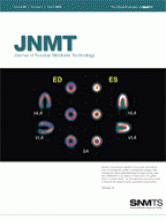
David Perry, CNMT, PET Executive Director Nuclear Medicine Technology Certification Board
The Nuclear Medicine Technology Certification Board (NMTCB) was formed for the purpose of creating and maintaining examinations for nuclear medicine technologists (NMTs). Since 1978, the NMTCB has offered a high-quality certification examination for NMTs. More recently, the NMTCB has provided specialty examinations for NMTs who have a high level of knowledge in nuclear cardiology technology (NCT) and NMTs, radiographers, and radiation therapists who have a high level of knowledge in PET.
In addition to developing and administering certification examinations, the NMTCB also provides maintenance of certification for its certificate holders. Through the end of December 2009, the NMTCB maintained certification for 23,747 active certified nuclear medicine technologists. Of those, 677 also held a specialty certification in NCT; 517 held a specialty certification in PET; and 47 held CNMT, NCT, and PET certifications. These numbers represented a 2% increase over the previous year.
The NMTCB offers the NCT examination to nuclear medicine technologists certified by the American Registry of Radiologic Technologists (ARRT) (RT(N)) and the Canadian Association of Medical Radiation Technologists (CAMRT), in addition to those certified by the NMTCB. There are currently 39 active nuclear cardiology technologists certified in nuclear medicine technology by organizations other than the NMTCB. In addition to nuclear medicine technologists certified by NMTCB, ARRT, or CAMRT, the PET examination is also offered to registered radiologic technologists and registered radiation therapists. As of this writing, there are 52 PET technologists who are qualified to take the PET examination through a route other than qualifying certification by the NMTCB.
2009 NMTCB EXAMINATION STATISTICS
A total of 1,466 candidates sat for the NMTCB examination in 2009. This number represents a 14% decline from the previous year and is the lowest number of candidates since 2004. Of all candidates who sat for the examination, 1,319 (89.9%) successfully passed it. The average scaled score for all candidates was 79.61, with a range of 66–99. A scaled score of 75 or greater is required to pass the NMTCB examination. Of note, of all candidates who sat for the 2009 examination, 285 (19.4%) passed with distinction with a scaled score of 82–84, and 167 (11.4%) passed with highest distinction with a scaled score of 86 or higher.
Graduates of nuclear medicine technology training program made up 1,286 (90.8%) of all candidates. Of these candidates, 1,213 (94.3%) successfully passed the examination. The average scaled score for these candidates was 80.21, with a range of 66–99. Among program graduates who sat for the 2009 examination, 280 (21.7%) passed with distinction, and 162 (12.6%) passed with highest distinction.
Although most candidates are graduates from nuclear medicine technology training programs of varying lengths, 86 candidates became qualified to sit for the examination through our alternate eligibility pathway. These candidates are individuals who have worked as nuclear medicine technologists for 8,000 hours (not counting on-call hours) during the past 5 years, as well as meeting certain other eligibility requirements. Of these 86 candidates, 64 (74.4%) passed and 22 (25.6%) failed. Four (4.7%) passed with distinction, 5 (5.8%) passed with highest distinction, and the average score was 76.66. This alternate eligibility pathway will close at the end of 2015, and all applications to take the examination through the alternate eligibility pathway, along with all requisite fees and documentation, must be received in the NMTCB office by December 31, 2010.
BOARD OF DIRECTORS
As is the case every spring, the NMTCB must bid farewell to departing board members while extending a welcoming hand to new ones. April Mann and Danny Basso both served on the NMTCB Board of Directors from 2001 through 2009. Danny served as chair of the board from October 2006 through September 2007, and April was chair from October 2007 through September 2008. In addition, both were instrumental to the development, implementation, and continued success of the nuclear cardiology technologist specialty examination. We will miss them and wish them both all of the best.
The NMTCB Board of Directors is composed of 18 individuals. At all times, 1 director is a physician member of the SNM; 1 director is a physician or scientist at large who is an SNM member; 1 director is a representative of the American Association of Physicists in Medicine; and 1 director is a representative of the Specialty Council of Nuclear Pharmacy. Twelve directors are nuclear medicine technologists certified by the NMTCB, and the selection of the remaining 2 is based on the specific needs of the NMTCB Board of Directors.
Every year, the NMTCB has one or more technologist directors whose term is ending, and we seek applications from candidates interested in filling these vacancies. If you are a certified nuclear medicine technologist and are interested in serving on the board, please see our Web site at www.nmtcb.org/resources/directorApp.php for more information and to access our application and conflict-of-interest policy. The next application deadline is August 15, 2010. Replacing April and Danny are 2 new directors elected to the board at the fall 2009 meeting. Angela Foster is a certified nuclear medicine technologist from the Omaha, Nebraska, area and brings several years of experience and a lot of enthusiasm to this position. Nancy McDonald DeLoatch is from Jacksonville, Florida. She has been active in the nuclear medicine community for a long time and is among the first technologists to become NCT-certified. We welcome both of them and look forward to their successful future with the NMTCB.
Should you have any questions about the NMTCB or any of our certification programs, please feel free to contact us through our Web site at www.nmtcb.org/about/contact.php or our e-mail address at board@nmtcb.org.







